Etruscan Art – Introducing the Intricate Art of the Ancient Italians
You may have heard of ancient Greek and Roman art, but do you know about the rich diversity of Etruscan art? Etruscan art history has its roots in central Italy as early as the 8th century BCE, and provides depth to European art and the history of painting as expressed by early Italians. In this article, we will explore the vivid art forms of Etruscans, as well as a selection of distinct art pieces that encompass the artistic styles of early Italian culture. Read on for more about the specialties of the Etruscan art world and all it had to offer!
An Introduction to Etruscan Art and Culture
The Greeks were best known for their flawless sculptural techniques while the Romans adapted and transformed elements of Greek culture into towering and complex narrative artworks. So, what were the Etruscans known for? From vibrant wall paintings to intricate bronze carvings and bucchero pottery, the Etruscan art world had its origins in central Italy many centuries ago, between the 8th and 3rd centuries BCE. The Etruscan civilization was a highly developed society with a culture that was influenced by ancient civilizations and encompassed the city-states of Etruria. The Etruscan time period is generally marked as between the 10th and 1st centuries BCE.

The Etruscan culture was divided into different city-states, each with its own government and ruling aristocratic families who governed the most important sectors such as mining, agriculture, and trading. The Etruscan culture was best known for its contribution to metalwork and the production of fine bronze sculptures and jewelry. They were also known for their distinct black pottery called bucchero pottery, including vibrant and intricately decorated paintings. The Etruscans also developed a sophisticated system of writing that they used to record ritual practices and religious events. Other major societal developments included the development of aqueducts and roads, which were used for transportation and irrigation systems as well as advanced drainage systems that enabled the cultivation of fertile farmlands in swampy areas. Needless to say, the Etruscan culture provided some of the most significant developments of the time.
In addition to the many societal developments provided by the Etruscan culture, the visual arts also resulted in a range of art forms such as frescoes, pottery, and sculpture, which were praised for their realistic Etruscan sculpture was also influenced by the dominant Greek style but was also fused with a unique twist inspired by Etruscan culture. Sculpture in the Etruscan age was employed primarily for decor in public buildings and temples. The decoration of pottery was also one of the minor art forms that included vibrant paintings and intricate designs. The Etruscans were also famous for their wall paintings and fresco portraying scenes from everyday life, including mythological subjects and religious themes. The pigments that the Etruscans used for their frescoes were produced from natural pigments and were used to render highly detailed scenes.
When understanding the basics of the Etruscan civilization, it is also important to realize that the Etruscan culture was exposed to other Mediterranean cultures, which prevented the development of an isolated or distinct art style.
With trade, agriculture, and the different city-states, art was influenced by ideas and objects imported from Greece, the Middle East, and Phoenicia. Many Greek artists also moved to Etruria around the 7th century BCE, which resulted in most notable Etruscan artworks containing the signatures of artists with Greek names. The adoption of foreign art styles and themes was also prevalent in the Etruscan culture and included the production of nude female deities and a blend of Eastern motifs and subjects with Greek cultural heritage. Below, we will explore the different art forms of the Etruscan culture along with a selection of famous art pieces for each art form to help you visualize the capabilities of Etruscan art.
The Vibrant World of Etruscan Painting: Tomb Frescoes
The Etruscan painting was most famous for its vibrant characteristics housed in many intricately-decorated tombs across Vulci, Cerveteri, Tarquinia, and Chiusi. The many tomb frescoes portray scenes from daily Etruscan life as well as mythology, architecture, heraldic figures, and a few areas simply for appreciating the art of decor. Walls in the tombs were separated into specific areas for decoration and included an entablature (top cornice), ceiling-high painting scenes in triangular spaces, and a large central arena for narrative scenes.

Many tomb paintings also rarely depicted scenes linked to death and burial and focused primarily on earthly pleasures and joys. The Etruscan elites were famous for living luxurious lives and often held banquets with exotic foods. Etruscan women were also showcased in drinking party scenes in comparison to Greek culture, which did not permit women to attend drinking events.
Paints were produced using natural pigments and resulted in many bold colors. The Etruscan style of painting did not contain much tonal variation until artists from Magna Graecia introduced it in the 4th century BCE via strong contrasts known as the chiaroscuro method. Other prominent scenes included outdoor banquets and events featuring dances, fishing, hunting, competitions, and funerary activities. Some of the popular sports found in Etruscan frescoes include depictions of boxing, wrestling, jumping, and discus-throwing.
Music was also a prominent feature in many Etruscan paintings and included figures playing instruments such as double aulos flutes and tortoiseshell lyres, which showcased their appreciation for culture and entertainment.
In areas such as Tarquinia, Etruscan artists prepared their paintings by outlining their composition using chalk or charcoal on a thin layer of plaster wash before applying the pigment. Other Etruscan wall paintings in Cerveteri and Veii were created using a direct application into the walls without a “primed” layer of plaster. A total of only 2% of Etruscan tombs were ever painted and represent the 2% of elite families in Etruscan culture, who had access to the fine arts. Below, we will explore a few famous Etruscan wall paintings that illustrate the culture of the time.
The Francois Tomb at Vulci (c. 4th Century BCE)
| Artist Name | Unknown |
| Date | c. 4th century BCE |
| Medium | Fresco |
| Dimensions (cm) | Unavailable |
| Where It Is Housed | Ponte Rotto Necropolis, Vulci, Italy |
The François tomb is a well-known site containing a 4th-century fresco of a battle scene between the Etruscans and the Romans. The tomb was named after Alessandro François who was accompanied by Adolphe Noël des Vergers in 1857 and discovered the site in Vulci. According to their description of the tomb, the site was a treasure trove of ancient Etruscan warriors with “brilliant tableaux on painted walls”. The tomb was built as a family burial monument that was used for around seven centuries and was structured as an elaborate T-shaped home for the dead.
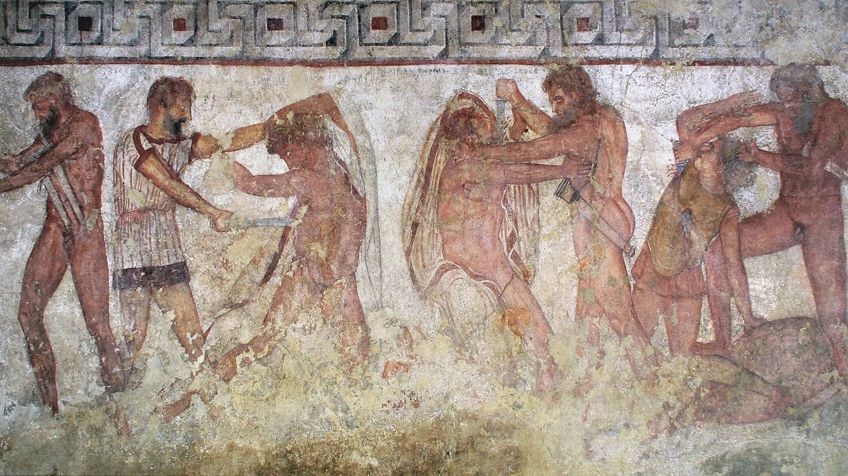
This reflected the Etruscan belief that the afterlife was a mirror of earthly life, and as such, tombs were built in a complex manner. What makes the François tomb so unique is that it contains a rare battle scene in its main chamber with other frescoes decorating the ceiling. The design of the tomb mimicked the interior of a building and the walls were decorated with geometric and figurative designs. The tomb’s entrance contains a hunting scene with life-sized human figures and features a mix of characters from history, mythology, and the tomb’s owner.
Another scene in the tomb showcases Achilles engaging in sacrificial activities for the shade of Patroclus.
Tomb of the Monkey (c. 480 – 470 BCE)
| Artist Name | Unknown |
| Date | c. 480 – 470 BCE |
| Medium | Fresco |
| Dimensions (cm) | Unavailable |
| Where It Is Housed | Chiusi, Tuscany, Italy |
Tomb of the Monkey is one of the most popular Etruscan tomb frescoes that features a monkey sitting in a tree with another scene showing a woman in a red robe sitting under a parasol with her feet resting on a stool. The woman observes a parade of entertainers, including figures of dancers, jugglers, and athletes. An interesting scene of a dancing woman is also portrayed where she balances an incense burner on her head to create a target for the drinkers to hurl their leftover wine at. The ceiling of the tomb also illustrates a coffer with four siren figures backing a rosette with a four-leafed plant. This intriguing motif also features in Roman and early Christian architecture with angels in place of the sirens.

Etruscan Sculpture: Cultural Fusion
Sculpture flourished in the Etruscan time period between the 9th and the 1st centuries BCE, which saw a boom in the artistic interest in sculpture throughout Northern and central Italy. One of the primary characteristics of Etruscan sculpture was the focus on tradition and a connection with external influences from Greece and the Near East throughout the 6th to the 8th centuries. Etruscan sculptures were made from urban materials such as bronze, alabaster, and terracotta, however, stone was somewhat of a rare find for Etruscan art.
Some of the most notable Etruscan sculptures include the Urna degli Sposi (c. 80-90 BCE), Ombra della Sera (c. 3rd century BCE), and the Sphinx of Chiusi (c. 570-560 BCE).
Etruscan funerary art is an example of an Etruscan art form that was built on archaic Greek models of sculpture combined with different cultural ideas in the visual arts. The unique blend of different artistic influences is what makes Etruscan funerary art so special. These types of sculptures were created for the commemoration of the deceased and were often placed in burial contexts or tombs.
Sarcophagus of the Spouses (c. 530 – 510 BCE)
| Artist Name | Unknown |
| Date | c. 530 – 510 BCE |
| Medium | Terracotta |
| Dimensions (cm) | 114 x 190 |
| Where It Is Housed | National Etruscan Museum, Rome, Italy |
Etruscan funerary sculptures included sarcophagi, which were crafted using stone or terracotta and then carved with intricate scenes from daily life or mythology. A 6th-century Etruscan sarcophagus known as the Sarcophagus of the Spouses is a famous terracotta sarcophagus illustrating a reclining couple on a couch. The couple is portrayed as sharing a drink while holding hands and represents the continuation of earthly life after death.

Tomb sculptures were another form of funerary art that was created as life-sized portraits of the dead and were crafted from bronze or terracotta. These funerary sculptures were sculpted realistically and executed in full detail. Some of the best institutions to view Etruscan artifacts and sculptures include the Museo Nazionale Etrusco in Viterbo and the Museo Archeologico di Vulci in northern Lazio.
The Museo Nazionale Etrusco di Tarquinia in northern Rome is also a fantastic option.
Chimera of Arezzo (c. 400 BCE)
| Artist Name | Unknown |
| Date | c. 400 BCE |
| Medium | Bronze |
| Dimensions (cm) | 78.5 x 129 |
| Where It Is Housed | National Archaeological Museum, Florence, Italy |
This famous Etruscan statue known as the Chimera of Arezzo dates back to the early 5th century BCE and is an excellent example of Etruscan metalwork. The Etruscan statue was first discovered in 1553 in the city of Arezzo and is currently housed at the National Archaeological Museum in Italy. The mythical sculpture was inspired by a hybrid creature called a chimera, which was a fusion of a goat, lion, and serpent. The chimera shows a lion’s head at the forefront with a goat’s head at the back and the serpent head emerging from the back of the goat.
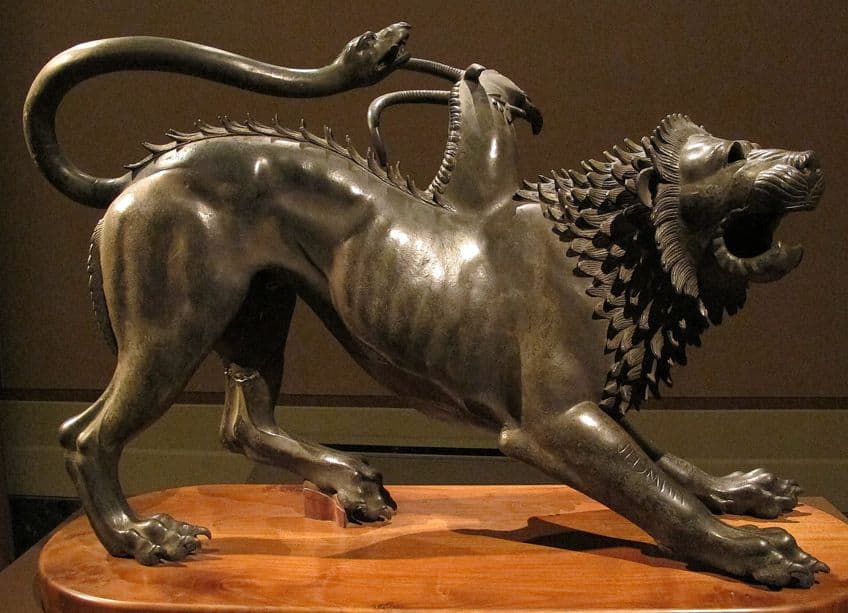
The stunning intricate details are also highlighted as the chimera symbolized the God of the underworld, who was also the creator and destroyer of life. The Chimera of Arezzo is thus considered to be a votive Etruscan statue that was created as a symbol of strength and power and a tribute to the Etruscan civilization and its capabilities. The sculpture remains one of the best bronze statues from the Etruscans to date and is admired for its detailed rendering of scales, fur, and muscles.
The bronze casting techniques used on the statue are also considered particularly advanced for the time it was created, which adds significant value to the work in the broader context of Etruscan sculpture.
Mars of Todi (5th – 4th Century BCE)
| Artist Name | Unknown |
| Date | c. late 5th – early 4th century BCE |
| Medium | Hollow cast bronze |
| Dimensions (cm) | 141 (h) |
| Where It Is Housed | Gregorian Etruscan Museum, Vatican Museums, Italy |
Mars of Todi is one of the best-known bronze Etruscan statues of the late 5th and early 4th centuries BCE that was discovered in 1835 in Todi. The Etruscan statue was produced in Umbria and is considered a product of an Etruscan workshop. The figure stands at a near-life-sized height of 141 cm tall and demonstrates the metalwork talents of sculptors from Volsinii. Believed to be a votive sculpture, the statue presents a warrior dedicated to the Etruscan God Laran, who was the God of war.

The figure was sculpted in a contrapposto stance, which echoed the stylistic conventions of Classical Mediterranean art. Today, the statue is considered a rarity in the genre of votive Etruscan sculptures, many of which have not survived since the age of antiquity. The object was also found carefully buried and once also contained libation elements, which would have matched the tradition of libation practiced by soldiers before battle. This was a ritual prayer where soldiers beseeched the Gods for their support during wars.
Mars of Todi is also a symbol of the Etruscan’s diverse interaction with each other, where such votive sites were places that encouraged communion and engagement during ritual ceremonies.
Etruscan Pottery
Etruscan pottery was based on four primary types covering utilitarian and fine art pieces with painted scenes that showcase the Etruscan artists’ eyes for detail and passion for storytelling. Pottery was the most important art form for the civilization’s material culture and included the broad classifications of black-figure pottery, bucchero, red-figure pottery, and terra sigillata. Black-figure pottery was a popular form of pottery since the 6th century BCE and was defined by the use of black figures against a red background. Black-figure pottery was often painted with geometric shapes and mythological scenes.

The François Vase (c. 570 BCE)
| Artist Name | Ergotimos (potter) and Kleitias (painter) (c. 6th century) |
| Date | c. 570 BCE |
| Medium | Terracotta |
| Dimensions (cm) | 66 |
| Where It Is Housed | Museo Archeologico, Florence, Italy |
The François vase is another famous Etruscan vessel, which is an example of black-figure pottery. This type of pottery was especially used for decoration and would contain scenes from mythology and daily life for added splendor. The François vase was painted with around 270 figures included in a mythological story featuring the death of Troilus the Trojan prince and the wedding of Thetis and Peleus. The vase is a storybook of Greek epic poetry that was founded by Alessandro François during the excavation of an Etruscan tomb in the mid-1800s.
The vase was originally produced in Greece around 570 BCE and is an example of the consumer culture of Etruria, which supported the importation of many Greek works.
The François vase contains two signatures; one of its maker, Ergotimos, and another of its painter, Kleitias. The uniqueness of the vase was attributed to its shape and painterly quality, which was a product of the collaboration between Ergotimos and Kleitias. The vessel is also characterized as a volute krater, which was a vessel used for combining water and wine. These types of vessels usually had curly handles and can be seen enlarged on the François vase. Along with the 270 characters on the vase, the artists also included a text of labels, which helped scholars better understand the artwork. Pottery classified as bucchero was popular between the 7th and the 5th centuries BCE and was created using a special method. This method involved firing the pottery in an oxygen-free environment, which helped turn the clay a black color. Bucchero decorations typically included incisions or raised designs and patterns that were linked to funerary and ritualistic practices.
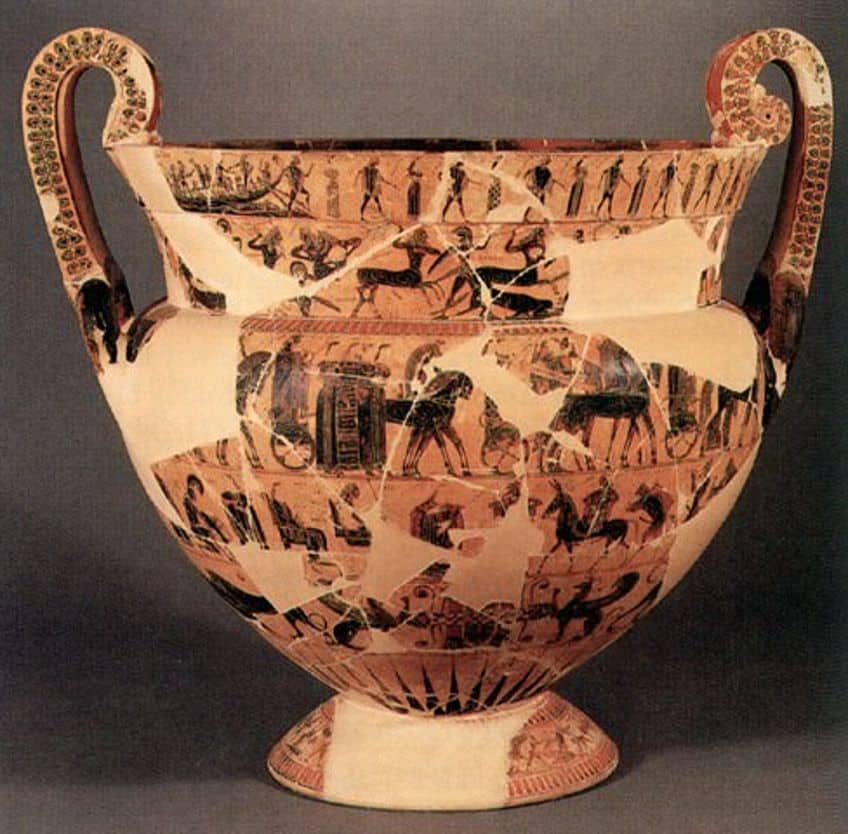
Terracotta Column-Krater (c. 560 – 500 BCE)
| Artist Name | Unknown |
| Date | c. 560 – 500 BCE |
| Medium | Terracotta |
| Dimensions (cm) | 41 x 34.5 |
| Where It Is Housed | The Metropolitan Museum of Art, New York City, United States |
The term “bucchero” is derived from the Spanish word búcaro, which translates in English to “ceramic jar” or an “aromatic clay”. Bucchero became the signature tableware of the Etruscan elite and was characterized by its smooth and grit-free surface, which made it an object of high-quality and fine art manufacturing. This bucchero vase is a heavy bucchero vessel known as a bucchero pesante and is considered unique since it contains six handle straps as opposed to the typical two. The largest straps are also decorated with lions as opposed to human masks, which makes the vessel stand out. The four smaller straps feature a truncated warrior with armor, a crested helmet, and two spears.
The shape of the vase was inspired by Corinthian metallic vessels and is believed to be a new hybrid version of the traditional Greek cosmetic jar, as indicated by the original human mask straps.
Another famous example of Etruscan pottery was terra sigillata, which was produced in Etruria around the 2nd century BCE and was defined by its glossy surface. Terra sigillata was popular throughout the Roman Empire and is described in archaeology as “medieval medicinal earth”. These types of vessels were frequently exported from Gaul and Italy and ranged in aesthetic quality from glossy surfaces to brilliant sheens. The popular colors included bright red and orange and were created in a variety of sizes and shapes.
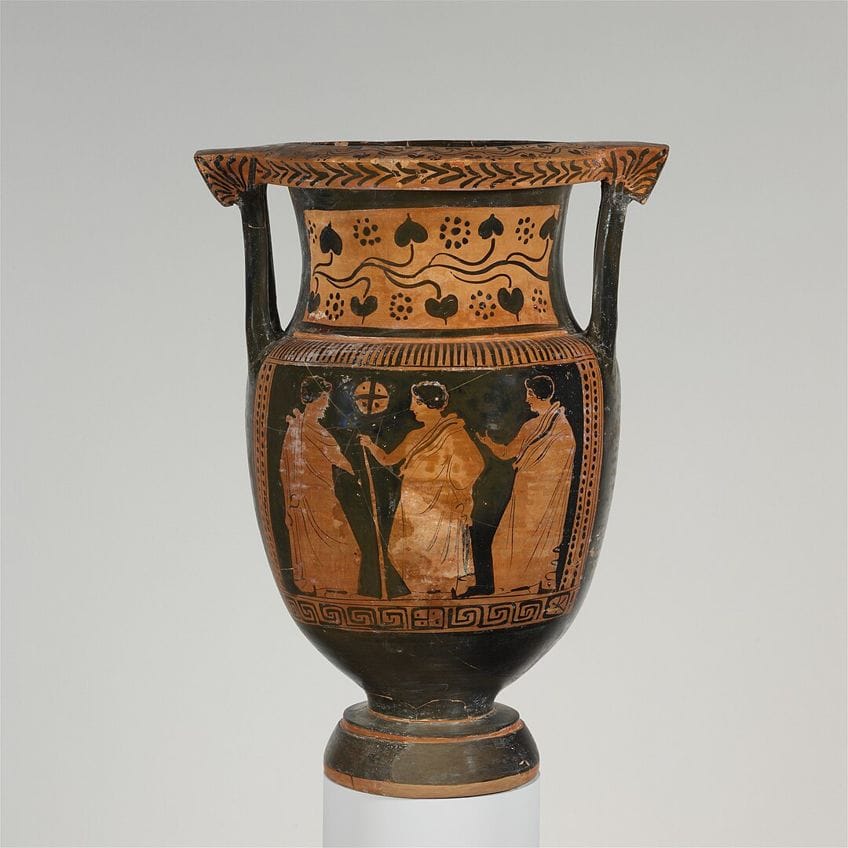
Gold in Etruscan Art
Gold was used for various purposes in Etruscan society. In art, goldsmiths would use their technical skills to craft many exquisite pieces of jewelry and other decorative art objects, which functioned as symbols of wealth, social status, and power. From necklaces to rings, and bracelets, gold jewelry thrived among the elite.
In addition, these pieces even incorporated semi-precious materials such as enamel, glass, and stones in various creative designs.
Some of the popular motifs in Etruscan jewelry included animals such as sphinxes, bulls, sirens, and other mythological creatures. Gold was also used to produce small figurines and votive objects as offerings to the Gods and was often located in tombs. Etruscan objects such as caskets and mirrors were also decorated with gold leaf and gold inlays for an added sense of luxury and exorbitance.
Set of Jewelry (Etruscan Gold) (c. 5th Century BCE)
| Artist Name | Unknown |
| Date | c. 5th century BCE |
| Medium | Gold, agate, rock crystal, glass, and carnelian |
| Dimensions (cm) | 36 x 6.1 x 5 |
| Where It Is Housed | The Metropolitan Museum of Art, New York City, United States |
Discovered in an Etruscan tomb in Vulci in 1832, this set of gold jewelry was uncovered amidst the tomb group of Etruscan jewels, which was the most impressive and valuable discovery of Etruscan gold jewelry to date. The jewelry set is made up of gold, precious gems, and glass with a gold dress fibula ornately decorated with a sphinx. Two of the rings in the set of five are also engraved with scarab beetles that revolve on a swivel bezel.
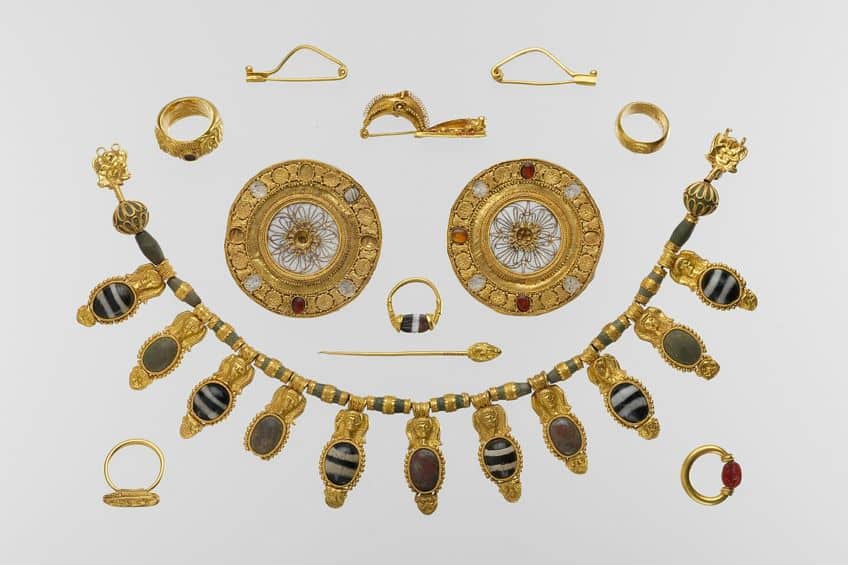 Set of Jewelry (Etruscan Gold) (c. 5th Century BCE); Metropolitan Museum of Art, CC0, via Wikimedia Commons
Set of Jewelry (Etruscan Gold) (c. 5th Century BCE); Metropolitan Museum of Art, CC0, via Wikimedia Commons
Bronze Mirrors
The Etruscans also specialized in creating bespoke bronze mirrors that formed an essential part of the society. How so? you may wonder. These practical handheld mirrors were also a symbol of one’s social status and as such, were created in a variety of ways to convey the owner’s social standing. These mirrors would be silvered on one side and protected using a concave cover that could also reflect more light on the user’s face. The reverse side of the mirror could be left blank or decorated with intricate engravings, shallow relief carvings, inscriptions, and many other personal motifs. The handles of the bronze mirrors would be created using a tang at the base, which would be inserted into a handle crafted from ivory, wood, or bone.
Handles were also produced with ornate designs and hand-carved relief features that further elevated the mirror’s luxurious aesthetic.
Bronze mirrors were also used as part of an Etruscan bride’s dowry and were seen as a cherished possession by aristocratic women. Etruscans referred to these mirrors as Malena or Malstria and were created from the 6th century until the 2nd century BCE. Thousands of Etruscan mirrors have survived due to the large number of mirrors buried with their owners, thus resulting in the society of Etruscans gaining the title of “narcissists of the Mediterranean”. Bronze mirrors were also found in tomb paintings where they were carried by a lady’s maidservants. These ancient artifacts also shed light on the literacy of women in Etruscan society since many mirrors often had inscriptions on them with the names and descriptions of their owners.

Etruscan art offers much insight into the remarkable craftsmanship of the ancient Etruscan civilization and the many unique styles that emerged from their society. Etruscan art is not only an important historical reference for archaeologists, but also a demonstration of the way that art can be incorporated across religion, society, and the visual arts, all admired for their own aesthetic sensibilities. By studying art from the Etruscan culture, one can gain a deeper understanding of the development of art, sculpture, and painting in the Mediterranean region.
Frequently Asked Questions
What Is Etruscan Art?
Etruscan art refers to artwork created in central Italy by the Etruscan civilization, which functioned between the 10th and 1st centuries BCE. Etruscan art relied on Greek art styles and imported goods, which were considered to be the standard for most artists.
What Are the Popular Art Forms of Etruscan Art?
Art forms such as sculpture, wall painting, funerary statues, bronze mirrors, jewelry, and pottery were considered to be the popular art forms of Etruscan art.
What Were the Etruscans Known For?
Numerous societal developments took place under the Etruscan civilization. These include the development of aqueducts and roads. They were also best known for their artistic contributions to metalwork, bronze sculpture, colorful wall paintings, jewelry design, funerary sculptures, and bucchero pottery.
What Makes Etruscan Art Significant?
Etruscan art is incredibly significant since it gives scholars insight into the cultural fusion of art from Greece and the broader Mediterranean that were used as the foundation of new Etruscan art styles. Etruscan sculptures from antiquity are also rare and are among the most important pieces of evidence for studying the Etruscan civilization. Etruscan art provides us with information on how visual art styles emerged through the trade network, since central Italy was an active trade participant in the exchange of artworks and art objects.
Liam Davis is an experienced art historian with demonstrated experience in the industry. After graduating from the Academy of Art History with a bachelor’s degree, Liam worked for many years as a copywriter for various art magazines and online art galleries. He also worked as an art curator for an art gallery in Illinois before working now as editor-in-chief for artfilemagazine.com. Liam’s passion is, aside from sculptures from the Roman and Greek periods, cave paintings, and neolithic art.
Learn more about Liam Davis and about us.
Cite this Article
Liam, Davis, “Etruscan Art – Introducing the Intricate Art of the Ancient Italians.” artfilemagazine – Your Online Art Source. October 2, 2023. URL: https://artfilemagazine.com/etruscan-art/
Davis, L. (2023, 2 October). Etruscan Art – Introducing the Intricate Art of the Ancient Italians. artfilemagazine – Your Online Art Source. https://artfilemagazine.com/etruscan-art/
Davis, Liam. “Etruscan Art – Introducing the Intricate Art of the Ancient Italians.” artfilemagazine – Your Online Art Source, October 2, 2023. https://artfilemagazine.com/etruscan-art/.


